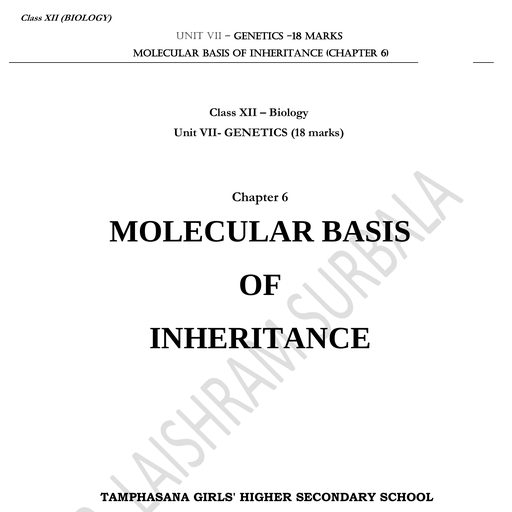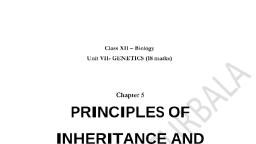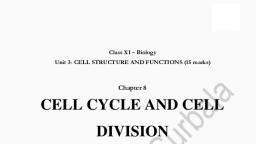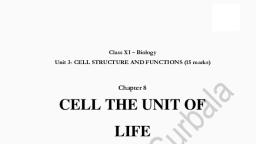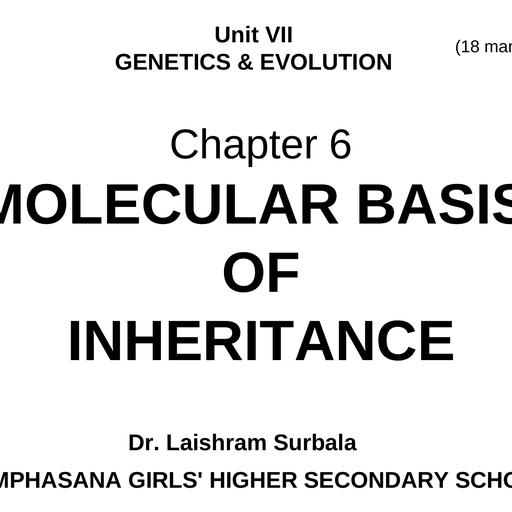Page 1 :
Class XII — Biology, Unit VII- GENETICS (18 marks), , Chapter 5, , PRINCIPLES OF, INHERITANCE AND, VARIATION, , TAMPHASANA GIRLS' HIGHER SECONDARY SCHOOL, MANIPUR, , , , IMPORTANT TERMS:, , , , TAMPHASANA GIRLS’ HIGHER SECONDARY SCHOOL
Page 2 :
GENETICS: A branch of biology that deals with the inheritance, as well as the variation of characters, from parents to offspring., , INHERITANCE: It is the process by which characters are passed on from parent to progeny; it is the basis, of heredity., , VARIATION: It is the degree by which progeny differ from their parents/ It is the occurrence of different, characters among the individuals, , GENE/FACTOR: Genes are units of inheritance that contain the information that is required to express a, particular trait in an organism., , ALLELES (ALLELOMORPHS): Alleles are the alternate forms of a gene located on the same loci of a, homologous chromosome pair., , LOCUS: It is a specific region in the chromosome where a gene is located., , PHENOTYPE: The external appearance of an organism is called phenotype., , GENOTYPE: Genetic constituent of an organism is called genotype., , PUNNET SQUARE: It is a checker board used to show the results of a cross between two organisms., , MENDELIAN INHERITANCE, , e Gregor Johann Mendel (1822 to 1884) was an Austrian monk., , e Mendel proposed the laws of inheritance in living organisms by performing hybridisation, experiments in garden pea (Pisum sativum)., , e Mendel was the first to suggest principles of heredity because of which he is regarded as Father of, , enetics., , . His work was published in the proceedings of “Brunn Natural Science” in 1865. However, his work, was unnoticed., , e His work was rediscovered in 1900, long after Mendel’s death, by E.V. Tschermak, Carl Correns, and Hugo DeVries., , e 7 pairs of contrasting characters of peas were selected., , e Acharacter is a well defined morphological or physiological feature of an organism. A character, , may have different forms called traits. Eg. tall and dwarf are two different traits of the character, stem height., , Reasons for Mendel’s success: [~_ Reasons for selecting Pisum sativum, (1) He worked with true breeding varieties of pea . (1) Pure varieties of pea were available., , 4 (2) Pea plant showed easily detectable characters., (2) He chose only those characters which showed (3) It is a bisexual flower., , consistent result. (4) Control breeding is easy., ), ), , , , (3) Mendel worked with only 1-3 traits at a time. (5) Easy to cultivate., , (4) He applied statistical analysis and mathematical logic| (6) Short life span., , (5) He took large sample size. —, , , , 7 pairs of contrasting characters of pea plant studied by Mendel:, , , , TAMPHASANA GIRLS’ HIGHER SECONDARY SCHOOL
Page 3 :
Sl.No. _| Characters Dominant trait Recessive trait, 1 Stem height Tall Dwarf, , 2 Flower colour Violet White, , 3 Seed shape Round Wrinkled, , 4 Seed colour Yellow Green, , 5 Pod shape Full Constriction, , 6 Pod colour Green Yellow, , 7 Flower position Axillary Terminal, , , , , , , , Ste, ps involved in Mendel’s cross in pea plants:, |. Selection of pure/true breeding parent plants, Il. Cross pollination of selected parent plants to obtain F1, generation, Ill. Selfing of F1 plants, , N.B., e A True breeding: line is one that shows the stable, inheritance and expression of a trait for several generations., It can be produced by performing continuous self, pollination for several generations., , ¢ Emasculation: It is the removal of stamens or anthers of a, bisexual flower so as to get a female flower without male, part., , INHERITANCE OF ONE GENE:, , Mendel’s Cross between a Tall and a, Dwarf pea plant parental, e Mendel crossed tall and dwarf pea, plants to study the inheritance of one, gene (Figure 1)., e He collected the seeds produced as a, result of this cross and grew them to F1 generation, generate plants of the first hybrid, generation (Filial 1 progeny or the, F1). Mendel observed that all the F1, progeny _ plants were tall, like one, of its parents; none were dwarf. F2 generation, e Mendel then self-pollinated the tall F1, plants and collected the seeds, produced as a result of this cross., , Petal, ‘Stigma, “Anther, ‘Stamen, ‘Carpet, , , , , Removal of anthers, , , , , , ‘Transfer of pollen (~, , Ne mae, aan, , iii, , Fig. 1: Steps in making a cross in pea, , $, , Tall Dwarf, , Tall, , Tall Tall Tall Pas, , Fig.2 : Diagrammatic representation of monohybrid, , , , TAMPHASANA GIRLS’ HIGHER SECONDARY SCHOOL
Page 4 :
e To his surprise Mendel found that in the Filial2 generation some of the offspring were ‘dwarf ’; the, character that was not seen in the F1 generation was now expressed, , e The tall and dwarf traits were identical to their parental type and did not show any blending, that is, all the offspring were either tall or dwarf, none were of inbetween height, , Mendel’s Inference, , * Similar results were obtained with the other traits (eg. Flower colour, flower position, etc.) that he, studied., , * Mendel proposed that something was being stably passed down, unchanged, from parent to, offspring through the gametes, over successive generations. He called these things as ‘factors’(Now, we call them as genes)., , * Factors/Genes contain the information that is required to express a particular trait in an organism., , * Dominant and Recessive factor - In a pair of dissimilar factors, one dominates the other (as in the, F1 ) and hence is called the dominant factor while the other factor is recessive, + Alphabetical symbols are used to represent each factor/gene., * The capital letter is used for the trait expressed at the F1 stage (Dominant) and the small alphabet, for the other trait (Recessive). Eg. T- tall and t— dwarf, * Homozygous / true breeding - the allelic pair of genes are identical., True breeding /Homozygous tall plant = TT, True breeding /Homozygous dwarf plant — tt, * Heterozygous / hybrid - the allelic pair of genes are dissimilar/different., Eg. Heterozygous tall plant - Tt, e Monohybrid cross - a cross between two pure organisms in order to study the inheritance of a single, pair of alleles., e Dihybrid cross - a cross between two pure organisms in order to study the inheritance of two pairs, of alleles., , Cross between homozygous tall plants and homozygous dwarf plants, , , , Parental generation Tall Dwarf, , TT, , L™ J™N, om OQ OO, , x, a, , ST /, ae, Et Tall Tall Tall Tall, Tt Tt | Tt Tt, Selfing of F1 Tt x Tt, , Gametes, , F2, , , , (Tall) (Tall) (Tall) (dwarf), , F2 Phenotypic ratio - 3 tall: 1 dwarf, F2 Genotypic ratio - 1TT: 2 Tt: 1tt, , , , TAMPHASANA GIRLS’ HIGHER SECONDARY SCHOOL
